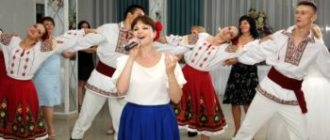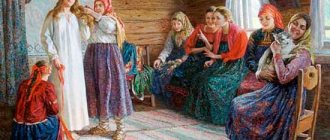Moldova is a small country located on a hilly plain between Ukraine and Romania. The complex, changeable fate of the Moldovan people is reflected in cultural traditions and holidays. People here have been farming for centuries, and many customs are associated with the wheel of the year, fertility and seasonal work. From ancient times to the present day, hospitable, welcoming Moldovans have carefully preserved their cultural heritage and the wisdom of their ancestors. A Moldavian wedding is the embodiment of the rebellious spirit of a small country, a time when you can touch with trepidation the amazing traditions of this people and plunge into the atmosphere of ancient folk festivities.
Moldavian wedding - celebration process, rituals
Another national event in the world is the Moldovan wedding.
It has a special character and southern flavor, which is why it is enchanting and colorful. No wedding celebration is carried out in a hurry. Young people need at least a year to prepare for the event. It is necessary to carefully consider all the details. It is mandatory to select a date in advance, strictly taking into account the church calendar. You must first go through the post. Advisors of the young family are invited to the celebration. Bread is baked and homemade wine is prepared.
From the origins of history
The tradition of inviting people to nanashi dates back to the first centuries after baptism. Nanash is also mentioned in the New Testament at the wedding of Can Galileo, where the Savior Christ was present and performed his first miracle, turning water into wine. After which he ordered first of all to give the wine to our people to try.
Orthodox Christians observe these ancient traditions and other customs that were handed down by the Holy Apostle Andrew. Of course, some details have changed over time, but the most important remains unchanged. The sacrament of marriage remains one of the seven holy acts that take place in the church in the presence and participation of Nanasha.
Matchmaking process
The first conversation between the relatives of the future husband and wife takes place on the day of matchmaking. Matchmakers are sent to the apartment where the girl lives. Their main obligations are to describe the groom's advantages and resolve certain issues.
Matchmakers predict the decision in advance. They find out about the intentions of the bride's relatives. The matchmaking process takes place on certain days: Thursday, Saturday or Sunday. Church holidays should not fall on these days. These days are considered lucky.
According to tradition, matchmakers make several requests.
- The bride is presented as the prey, and the groom appears as the hunter.
- A bargaining takes place between the future husband and the girl’s relatives.
- There is a statement of fact that there is a bride and groom.
Each side communicates its intentions, after which several actions are performed that are prescribed by the customs of the people. Moldovans believe that following all traditions helps protect the future family from bad events. The positive answer is the transfer of personal belongings to the future spouse.
After matchmaking, the engagement date is set. On this day, the bride gives the final answer. The difference between these two events is from 3 to 7 days. The bride is allowed to change her mind within 2 weeks.
On the day of the engagement, the girl's relatives came to the groom's home. This visit made it possible to verify the veracity of the groom's intentions. The man’s financial condition and ability to manage household affairs were assessed.
The bride's dowry was always discussed. If the future spouse and his relatives refused their decision in due time, then the bride could, if she wished, perform an unusual ritual called “On the Stove.” This process gives her the right to rescind the refusal and proceed with the wedding event with the groom, despite the opinion of his parents.
If the groom's relatives refused the wedding, the girl could be kidnapped.
Traditional marriage rituals
Wedding celebrations were traditionally scheduled in the fall. After the end of the harvest season, the best time came for a walk with the whole world, and with all the breadth of the soul. The bins were bursting with fresh fruits and vegetables, and the new wine was ripening, and the main hard work in the fields was over.
A wedding in Moldova was never hastily planned. A year, or even more, passed from the young couple's meeting to the wedding day. All this time, preparations were being made for the grandiose action and the subsequent feast. Every little detail was scrupulously taken into account, and the wedding date was chosen with all care: it should not fall on fasting or unfavorable days. Wedding witnesses and nashaul advisers were selected. They could only be a strong married couple, older than the newlyweds, but younger than their parents, who would help the newlyweds during the celebrations, and then begin to give wise advice in family life.
Matchmaking and engagement
The ancient traditions of a Moldovan wedding involve a mandatory matchmaking ritual. For this purpose, favorable days were always chosen - Thursday, Saturday or Sunday, but not on major church holidays or on days of fasting. Matchmakers were sent to the chosen girl's house, and the presence of the groom was not required. They described in colorful terms all the advantages of the young successful hunter who had spotted such a desired prey. In allegorical speeches and careful observance of the time-honored ritual, there is a sacred meaning: only in this way will the future family be protected from misfortunes.
If the girl’s parents gave preliminary consent to the marriage, then her personal belongings were handed over to the groom or his representative. Then followed a heated bargaining between both parties, when a ransom, sometimes quite serious, was demanded for the bride. Once the parties reached an agreement, a date for final agreement was set. This time, usually up to two weeks, was given to think and weigh all the pros and cons. At the end of this period, the agreement could either be confirmed or terminated without mutual claims. After this, an engagement was scheduled. Usually the preparation for it lasted about seven to ten days.
On this day, the bride's relatives paid a return visit to the groom's house, making sure that everything said about him by the matchmakers was true. And a young hunter is a truly worthy choice; he is a strong owner with skillful hands and will be able to adequately support his family. Hospitable hosts served a rich feast, and a leisurely conversation began. They discussed the details of future wedding celebrations, the list of guests, the day and the bride's dowry were set.
Considerable disputes often flared up over the size of the dowry. Usually the girl was given luxurious hand-embroidered carpets and carpet runners for the floor, embroidered towels and linen, and kitchen utensils. The boy’s parents, for their part, allocated a plot of land, materials for building a house, a work horse and tools.
Preparation period
The selection of nashauls was approached with great care. Not every couple was suitable for such a responsible role. And without their presence, the wedding could not have taken place at all - this is as indisputable an element of a Moldovan wedding as the newlyweds. The chosen married couple had to have family ties with the newlyweds and be happily married. Also, an important criterion was their strong financial situation and willingness to help and mentor the young family.
Invitation cards were baked goods lovingly baked by the hands of the young housewife - bagels, rolls or gingerbread. Ignoring an invitation was considered a serious insult, so such a responsible mission was not refused without a serious reason. In essence, these people became second parents for the newlyweds.
Nowadays, good acquaintances, friends of parents, or married couples from among the newlyweds’ peers are invited to play the role of nashauls. After this, an application for marriage registration is submitted to the registry office, a banquet hall is selected and booked if the wedding is planned to be held in a restaurant, and the holiday scenario is specified.
Traditional robes and modern outfits
National wedding costumes of Moldovans are masterpieces, hand-embroidered with amazing patterns. Making them takes a lot of time and effort, but it is worth it - no store-bought dress can compare with the exquisite simplicity and amazing patterns of folk wedding vestments. Silk, dyed cotton threads, beads, and beads are used for embroidery. The base is white, onto which red, black and blue patterns are sewn. Shirts, sashes and trousers are sewn for the groom, the dress for the bride must be embroidered along the hem, collar and sleeves, and an embroidered apron and belt are tied.
Modern newlyweds can also order outfits from an atelier, but the embroidery will be done by machine. Also, classic outfits for the bride and groom are quite popular among urban youth.
Festive outfits of young people
The customs of a Moldovan wedding are characterized by diversity. The beginning of the whole process begins with the preparation of the bride and groom for the special event. Friends and witnesses take part in dressing the young couple. The man is prepared first. Together with his comrades, he goes to Nana’s house. There, a ritual is carried out to invite them to the wedding.
After this, the witnesses, together with the nanas, visit the future spouse. Witnesses in Moldova are called vornichen and druzhka.
Then the young bride performs a dressing ritual. Girlfriends also take part in it. In this tradition, they sing songs dedicated to the girl’s farewell to her parents’ home.
The wedding event takes place in villages and villages. An important event is the selection of clothes. In Moldova, national costumes are used. They are distinguished by their beauty and originality. Decorating wedding clothes takes a lot of effort and time. The outfits are trimmed with threads and beads. The main color is white. But Moldovan costumes can be decorated with red, black or blue threads.
What to do if the newlyweds don’t find theirs?
On the one hand, there is the church and traditions inherited from our ancestors, which require those getting married to invite us to ours, on the other hand, we live in the modern world.
Increasingly, young people cannot find a nanasha for themselves, and this is due to the costs that fall on the shoulders of both parties. But until the last moment we must try to respect traditions and find a way to eliminate the costs of all participants and create a wonderful holiday.
What if the newlyweds still failed to find Nanasha? Can they get married? Can they organize this beautiful event in their life? In this case, the priest may become a nanash, but at the same time he will no longer be able to conduct the service. And then the priest will have to look for a clergyman who will conduct this Ceremony. Situations are different, and as practice shows, young people can get married without ours, and this does not mean that they will not be happy. Toastmaster at weddings, Irina Mikhalash, instructs young people that if nanashi are not found, they should not be upset and do not perceive this situation as an obstacle. Enjoy the time spent together, every moment - that's what's important. And if a couple decides to organize a wedding, they must do everything with great love and then be sure that the event will be unforgettable and full of positive emotions. And the guests won’t even understand that Nanasha is gone.
After all, starting a family is a great joy, and for many years Nanashi fulfills her duty to guide the young couple to maintain understanding and love between the newlyweds.
Moldavian weddings are played with and without nanash. Of course, a couple who managed to find spiritual parents is armed with useful advice and real life examples.
Views per week: 90 Views since publication: 8405
Selection of catches
One of the most important moments in preparation is the selection of our catches. This concept is usually understood as the second couple, which is necessarily present at the wedding celebration.
The young people face a difficult choice. Only married couples become nashaulami. In this case, several criteria are taken into account.
- They must be older than the bride and groom, but younger than their mother and father.
- To be wealthy and wealthy people.
- Willingness to become patrons and mentors of the bride and groom.
Gingerbread, rolls or buns are used as invitations. If guests refuse an invitation, it is considered a sign of disrespect. That's why people most often accept gifts. The duty of the nashauls is to organize the wedding celebration and support the newlyweds in all their endeavors. They are considered the second parents of the bride and groom. In modern times, acquaintances, friends and parents of newlyweds are chosen for this role.
The next stage of preparatory activities is submitting an application to the registry office and booking the premises where the celebration will be held. A dowry is also collected and a holiday script is drawn up.
What do they eat on holiday in Moldova?
A Moldavian wedding, like many celebrations, is characterized by pomp, fun and noise. Guests are served cold cuts and national dishes. If the event is held in the fall, it means there will be a rich table. This is due to the fact that at this time of year the harvest is harvested. The holiday in Moldova is distinguished by the serving of homemade delicious and aromatic wine.
Dishes in the form of Moldavian gogoshars and fekeluite beans are used as appetizers. Meat dishes include entrecotes and zrazy. The first courses include chorba and zama. Flour products in the form of rolls, Easter cakes, plancinda and vertut are always present on the table.
Ritual of undressing the bride
Weddings in Moldova are distinguished by another unusual tradition - the undressing of the bride. The ritual involves removing the veil and giving this item to an unmarried friend. The groom needs to give the boutonniere that was on his jacket to his single friend. Afterwards, the friend dances with the girl who was given the veil.
The undressing of the bride is also characterized by tying a scarf on her head. This gives the girl a new status as a “wife”.
Ceremonial dances in Moldova
Dancing at a Moldavian wedding is considered an integral part of the celebration. Often the dances are accompanied by cheerful and energetic music. Moldovans love live music, which creates a soulful atmosphere at the event.
The most popular dances include the traditional fiery round dance. The newlyweds dance it along with the guests. Looking at such active and fiery movements, no one can resist them. Also at Moldovan weddings they perform the shirt dance and the mask dance.
What happens after the wedding?
After the wedding, parents' day is held. It begins at 2 o'clock in the afternoon and continues until late in the evening.
On this day, newlyweds wear modest clothes. And their parents and nashauls opt for old things, since according to tradition they are beaten with nettles or smeared with mud. If relatives do not want this to happen, they have to pay off.
The second day is different in that strong chicken broth with homemade noodles is placed on the table. No meat or sweet dishes are consumed. Also on this day, competitions are held and dancing is performed.
A Moldavian wedding combines many traditions and customs of different nations. This allows you to make the holiday more colorful, fun and bright. National rituals must be preserved. In this way, young people show their respect and how much they value the culture of the people, and pass it on from generation to generation.
Traditions of a Moldovan wedding
A Moldavian wedding is one of many national weddings in the world. Having absorbed a special character and southern flavor, it became one of the most enchanting and colorful. None of the weddings are planned in a hurry.
Young people need at least a year to plan and prepare all the details of the future celebration. You definitely need to choose a date according to the church calendar, be sure to bypass fasting, invite the nashauls (the second main couple at the wedding, advisers to the young family), bake bread, prepare homemade wine, etc. Let's talk about all the details right now.
How does matchmaking and engagement work?
Moldovans begin the first official conversation about the upcoming wedding at the bride's matchmaking ceremony.
Matchmakers are sent to the young woman's house. Their responsibilities include a detailed description of all the advantages of the future groom and posing the main question.
Matchmakers should anticipate the answer in advance by finding out about the parents’ intentions to marry off their daughter. Mandatory days for matchmaking were: Thursday, Saturday or Sunday, if major church holidays did not fall on them. They were considered successful. Traditionally, there are several matchmaking requests when:
- the bride is represented as the prey, and the groom as the hunter;
- bargaining is carried out between the groom and parents for the bride as for a commodity;
- the fact is stated that there is a bride and groom.
In all these cases, the participants clearly communicate the intentions of the parties by performing certain actions prescribed by custom. According to faith, this helps protect the future family from misfortunes. A positive response to matchmakers is the transfer of any item of the bride into the hands of the groom. His presence, by the way, is not necessary.
But most young people do not miss the opportunity to participate in this ritual.
At the end of the matchmaking, the day of engagement and the day of the final answer are set. The time difference between them can be a week. The total time to think and change a decision is two weeks or more.
On the day of the engagement, the bride's parents came to the groom's house, checking the veracity of the matchmakers' words about his condition and ability to run a household. At the set table, the details of the future wedding, the day, the number of invited guests, etc. were discussed.
Wedding preparations
The most crucial moment in preparing a wedding celebration in Moldova is the choice of weddings. This is the second couple, whose presence is as mandatory as the presence of the young. Without them, the wedding simply cannot take place.
Making a choice is not easy; there are special criteria. Thus, a married couple who:
- necessarily older than the young, but younger than their parents;
- has family ties with young people;
- fairly wealthy;
- ready to become a patron and mentor of a young family.
Gingerbread cookies, rolls or other rich pastries serve as an invitation letter in this role. Refusal is considered a sign of disrespect, so generally the couple accepts the gifts and agrees. The duties of nashauls include assistance in organizing a wedding, supporting the newlyweds during the celebration and helping them during their future family life. In fact, they become second parents for the young. Today, the role of nashaul can also be played by acquaintances of married couples, friends of parents or newlyweds.
The next stage of preparation is submitting an application to the registry office, booking a restaurant, final collection of the dowry, clarifying the details of the script for the celebration itself, etc.
Our choice - in the past and today
The moment the newlyweds decide to get married, they should think about finding a nanashi. This wonderful tradition presupposes that nanashi should already be experienced and help the newlyweds with advice and conversations, says Archpriest Ioan. Young people were brought up in different families and their views cannot completely coincide. But if they want to create a strong family, nanashi helps them - they share their experience in family life and the life of a couple. There must be an example for a young family to follow.
If in the past nanashi were chosen to receive advice, support, and sometimes financial assistance, today newlyweds prefer to choose a couple with whom they can be friends. But there must be respect for the chosen ones, although free communication and the desire to spend interesting time together remain a priority today, says Irina Mikhalash.
Celebration
The morning of the wedding day begins with the bride price. This custom is very similar to Russian, the only difference is the name of the witnesses.
The groom represents the bride, and the groom represents the groom. They are the main ringleaders of the ransom. The competition program and questions for the groom are always developed by the groom, and if desired, Nashaula can help her.
Ransom must be fun. The introduction of roles as on the day of matchmaking is encouraged. The bride is “goods”, “doe”, “forest fairy”, the groom is “merchant” or “hunter”.
Much attention is paid to props and decoration of the bride's house.
Required attributes are:
- embroidered towels;
- ribbons and fabrics;
- flower crowns;
- rolls.
Modern posters, questionnaires, poems, jokes and much more are also woven into the traditional ransom. It all depends on the imagination of the bridesmaids, because it has nothing to do with the preparation of the ransom.
A feature of the Moldovan ransom is that it is accepted not only in money, but also in sweets, baked goods, and symbolic gifts. The next step is official registration at the registry office. Next, if everything has been carefully planned, the wedding ceremony takes place in a church or temple. This is an important point.
The day before, the young people must confess and receive communion. This is a prerequisite for a wedding.
Some temples also host preliminary talks on the values of seed life, and attendance is welcomed and encouraged.
The bride must enter the temple with her head covered, so it is worth putting on a veil or shawl in advance. A wedding wreath does not count. It will have to be changed. You should also not enter the temple after drinking wine. Therefore, the newlyweds are not served alcohol until the end of the official ceremony.
After the official part, it is time for the festive banquet. Usually it is held in a restaurant or in the groom's house, because... after the marriage is registered, the bride goes to live with him. According to tradition, on the way to the restaurant, children unexpectedly pour a bucket of water at the feet of the bride and groom, this means an obstacle in their lives.
It is important to go through it with a smile. From this moment the ceremonial part begins.
She is always full of fun and enthusiasm. Traditional competitions and rituals are held. There are toasts and a variety of music. Everyone is sure to dance and sing.
The romantic wedding music of the first dance of the newlyweds – “chora” – deserves special attention. It is chosen several months before the wedding and is performed with special reverence, becoming a symbol of the family.
After the dance there are toasts to the new family, parents and children. There will definitely be choral singing. The Moldavian wedding drinking song adds a special flavor to the celebration. It not only wishes the newlyweds happiness and love, but also talks about the difficulties of family life.
A Moldavian wedding lasts until the morning. And it is celebrated for three days.
The most fun and spectacular family ritual is the wedding of the newlyweds, where the bride and groom are the main participants and heroes of the celebration. Weddings were not held during Lent because it was a sin. The period of weddings is closely connected with agricultural activities, when work in the field ends then weddings take place.
Like other peoples, Moldovans have a belief that every guy and every girl has their own destined person. There are many forms of fortune telling for a betrothed. The basis of family consciousness is love and mutual understanding. The wedding of the newlyweds includes a series of customs and rituals: pre-wedding, wedding and post-wedding. Despite the fact that Moldova is a small country, each region has its own traditions, for example: dishes, the nature of the engagement, the ritual of receiving a dowry, the number of wedding bands, etc. In the past, in villages in the north, a wedding was celebrated for three days; in the center of Moldova, a wedding lasted a week with many customs and rituals. In the south, the bride went with her dowry to the groom after the engagement, and in the north on the wedding day.
Pre-wedding rituals and customs
Matchmaking. A traditional Moldavian wedding begins with matchmaking, when the groom and an older relative come to the bride’s parents to ask for her hand in marriage. There are certain forms of requests and appeals to the bride's parents. If the parents agree, an engagement follows a week or two later.
Engagement. The engagement ceremony usually takes place at the bride's home. At the engagement party, they discuss the nature of the wedding, propose the arranged parents, decide how many wedding bands are needed for the guests, sometimes agree on a dowry, etc. In the center and north of the country, only the closest relatives of the bride and groom come to the engagement party, who are witnesses to the contract. They set the wedding day, choose the music, dishes, the place where the wedding will take place, decide the share of participation of the guests and the contribution of the parents in organizing the wedding of the newlyweds.
Answer. A few days or a week after the engagement, a “response” is held at the groom’s home (everything is finally decided). The bride's parents come to the groom with several people and with the imprisoned parents, if at that time they have already been selected and have given their consent to participate in the wedding. The couple's decision to get married is confirmed with gifts; the girl's parents give rolls, towels and drinks.
The most revered people at a wedding are the bride, the groom and the married parents. It is an honor to be seated by parents at a wedding. There is a beautiful custom when the parents of the bride or groom give two rolls and a towel to the future parents. Parents give these rolls to people they want to be planted parents at their children's wedding, thus inviting them to become planted parents, and they must consider their options and accept the rolls, which will be considered consent, or refuse the rolls. In fact, it is not good to refuse to marry someone, because it is a sin to push them away from you. The young become like children to their imprisoned parents. If the married parents are chosen, then they can be present at the engagement and at the “answer”, they have the right to express their opinion about what the wedding should be like and what gifts are needed.
During the “answer”, the wedding day and its nature (big, small), wedding bands, dowry, parental contribution and gifts for the imprisoned parents, etc. are finally approved.
One of the most important tasks for the wedding was preparing the dowry. Disputes often arose when discussing the dowry of the bride and groom. In the center of Moldova, a girl was given as a dowry: carpets, rugs, towels, pillows, blankets, etc. In the Orhei region, until recently, girls were given a barrel of wine and a new barrel, because a lot of grapes are grown in the central part of the republic. Guys in this region were given: a place to build a house, building materials, a horse, etc. An interesting fact is that everywhere mothers prepare a blanket and a pillow for their sons, which they lay separately for their husband, in case he, God forbid, is in a quarrel with my wife. In past centuries, wealthy families placed large and expensive items on the “dowry list.”
In the central zone of Moldova, there are other pre-wedding customs: “day of sifting flour”, “cutting out a shirt by the mother-in-law”, “washing the bride”, “shaving the groom”, etc.
“Flour Sifting Day” is usually held on Thursday because it is considered a good day for doing housework. A boy and a girl are invited, flour and coins are poured into a sieve decorated with red ribbons, the children sift through the first sieve and take coins for their work. Then the family kneads the dough and bakes rolls for the arranged parents, matchmakers, and rolls for the bride and groom. The custom of “cutting out a shirt by the mother-in-law” has been preserved in the history of folk traditions, when the groom’s mother and one or two other women came to the bride and cut out the mother-in-law’s shirt, which the bride had to embroider before the wedding. Every custom contains elements of jokes and humor. The shirt was cut wide, with a narrow collar “so that the mother-in-law would not talk too much.”
Wedding invitation. Close relatives are supposed to be invited to the wedding with drinks; this should be done by parents or newlyweds. Especially for wedding invitations, honorary best men, tied with a scarf or towel, come on horseback with a beautiful wooden flask to invite the rest of the guests.
When one of the parents is no longer alive, they follow the tradition of going to the cemetery on the morning of the wedding day to symbolically invite them to the wedding. This gesture is associated with the beliefs and ethical laws of respecting the memory of ancestors.
Wedding
Bride's wedding. In the past, the wedding itself was celebrated on Sunday and lasted 2-3 days. According to tradition, the wedding began in the morning at the bride's house.
Dressing the bride. At home with the parents, first they dress the bride for the wedding - “dressing the bride” (if the groom brought a wedding gift in the evening - a dress, veil and shoes), and if not, then they waited for the groom to come with gifts. The bride is surrounded by groomsmen and a woman who prepares the bride. If gifts are brought on the wedding day, the man gives a wedding congratulatory speech in verse to the offerings. In the past, the bride gave the groom an embroidered national shirt and a belt as a gift; all this was presented on a roll, thus an exchange of offerings took place.
While dressing the bride, the groomsmen sing a song about the moment of farewell to freedom, smile, childhood, that she is one step away from starting a family and she will miss her parents, brothers and sisters, etc.
While dressing the bride, friends and relatives sing to her the sad song of the bride: “Be silent, the bride does not shed any tears, We will take you to your mother, When the cancer hangs on the mountain and the fish begins to sing...” Forgiveness of the bride. In the bride’s house they hold a “forgiveness of the bride”, she kneels before her parents, asks for forgiveness and a blessing to get married, and says goodbye to her home. Her parents bless her. “Forgiveness of the bride” can also be carried out together with the groom when he comes for her.
That same morning, the groom also has a “forgiveness” ritual, when the groom asks for forgiveness from his parents and receives their blessing. To “forgive” the groom, they set the table and put a roll of bread and a handful of wheat in the corners of the table as a symbol of abundance for the future. The groom kisses each roll and takes a little grain from each handful and throws it over his shoulder, then approaches his parents and asks for forgiveness and blessings.
Bride ransom. The groom, accompanied by music, groomsmen tied with scarves and groomsmen decorated with flowers, comes to pick up the bride. In some villages, the groom and his friends first come to the imprisoned parents, where they are seated at the table, then they all go together to buy the bride.
First of all, at the gate, the bride and groom exchange rolls, one of the rolls is broken into pieces and all the unmarried and unmarried try to get a piece as a sign of happiness.
At the gates of the bride's house, the parents meet the groom and his entourage with wine and a beautifully woven roll of bread. The parents raise the roll high and the groom and his guests pass under it. The bride greets the groom by pouring water in front of him, which symbolizes fertility in everything. Then all the guests sit down at the table - the “bride’s table”. When they get up from the table, everyone joins hands and goes out to the common chorus, to the bride’s dance, where she and the groom dance the first dance, they are surrounded by a chorus of young people. Then they take the dowry (if they didn’t take it after the engagement), which also represents a ritual. In some villages, baked chicken is placed on top of the dowry chest so that the young people eat it themselves and do not share it with anyone. At the bride's house, the groom is asked to pay a ransom for the dowry and the bride. Bargaining with jokes takes place between the groom and the bride's brothers and sisters; they place a knife at the door and demand a ransom.
After a symbolic payment, they take the dowry and dance the “dowry dance” to a special song - ostropets. All the dowry (carpets, pillows, runners, etc.) is taken out by the groom’s friends, lifted up and danced with him. It is an honor to have a rich dowry; the whole village will see it when they take it from the bride and take it home to the groom. People in the village have maintained the tradition of highly appreciating the hard work and skill of girls and condemning laziness and a small dowry.
When the groom and the bride leave the house, her mother throws wheat and sweets after them so that their life is sweet and the house is a full cup, so that no matter what happens, the bride should not turn back to the house so as not to return. The bride's ransom with the dowry is a very beautiful performance that all residents of the village are waiting for to watch the newlyweds as they, with music and the entire wedding procession, head to the registry office to register the marriage. Often water is poured in front of the newlyweds as a symbol of fertility and the groom scatters coins. Afterwards, the wedding cortege goes to the groom, but the bride’s parents and her married relatives do not go with them, but gather at the bride’s house and come in the afternoon.
The wedding cortege used horses, on which the honorary best men informed people about the wedding. The bride and groom walked, and if the groom's house was far away, then they rode in a carriage, and in winter on a sleigh. Today, the wedding procession consists of many cars decorated with flowers and ribbons. Along with bride price, the custom of “bride kidnapping” is traditionally found, which differs in the form of the agreement between the matchmakers and the nature of the wedding.
Vulpya - (“Fox” or “Vadra”) The “Vulpya” custom is carried out when the groom is from another village, and he takes the bride to his place, the guys block the exit from the village with chains, stand on barricades, preventing the bride from leaving the village and ask for payment for bride. They place a thread in the middle of the road and ask the groom for “vulpa” - a gift in the form of wine and money. Sometimes the groom tries to bypass the central road, but all exits from the village are guarded, especially if the girl is good. They ask for “vulpa” for her, thus showing their respect for the girl.
Reception of the bride at the groom's. The groom's parents are waiting for the "wedding", that is, the wedding procession with the bride and groom. They greet the young people with a roll of bread in their hands, treat the young people to cakes, wine, nuts, jam or honey, and then treat the imprisoned parents and other guests. Guests walk through the gate or threshold of the house under the kalach - a sacred symbol of wealth and honor. The groom's mother takes one end of the towel and throws the towel over the young people, grabs the other end so that the young people are in the towel, and leads the young people into the house. Afterwards, snacks are served on the table.
Groom's wedding. With the arrival of the newlyweds and guests, the wedding begins at the groom's home. The dancing begins and the villagers come to watch. Everyone dances until the evening. Guests arrive in an organized manner one after another, the most key moment is the arrival of the seated parents. They are met on the road leading to the house, the bride and groom and the musicians come out in advance and greet the seated parents with honor, after which they all enter the yard together. The bride's parents and her relatives are also greeted. When the bride's parents and relatives arrive, the first wedding table with snacks is served. The wedding takes place in the evening. They don’t say “they’re having a wedding,” but “they’re playing,” because a wedding should be fun.
Table for youth. Until recently, according to tradition, a table for young people was organized in the early evening, which began with the passage of the young people with burning candles, washing of hands, shaking hands and presenting gifts to the bride and groom by rural youth, after which they sat down at the wedding table.
They got up from the table and danced the hora, and the bride and groom were in the center of the circle. After several dances, the youth went home, and at this time invited guests arrived. Close relatives came during the day to see how the wedding was going and, if necessary, to help the bride. The arrival of the married guests was original. Each family came with a couple of rolls covered with a beautiful towel and a decanter of wine. The wife baked the rolls, and the husband carried them. The hostess was judged by how skillfully the towel was embroidered and how well the rolls were baked. Until midnight, everyone celebrates and waits for the “Masa Mare” (“Main Table of the Wedding”).
“Masa Mare” - (“Main Table”) This ritual in the wedding ceremony is the most important, if you are invited to the wedding, you can skip some rituals and stages, but you must be present at the “Masa Mare”. “Masa Mare” begins with the passage of the planted parents and newlyweds to the “seated table”, with burning candles that are stuck into the bride’s roll and the groom’s roll. During the feast, everyone eats, watches how the rituals are performed and how the candles burn, so they judge what the life of the young people will be like in the future.
Hand washing is a ritual that reminds of hygiene and demonstrates the attitude of Moldovans towards it. Cleanliness of the home and body has always been very important. The ritual of “washing the hands” begins from the moment when the groom pours water on the hands of the newlyweds, and the bride gives them a towel to dry their hands, then the arranged parents pour water on the hands of the newlyweds and give them a towel. After this, the “masa mare” begins under the guidance of the planted parents, who are assisted by matchmakers and honorary best men.
The tying ritual (“Legetorile”). The ritual of tying is a performance of great significance. “Legetorile” are gifts given by the bride’s parents to the married parents and relatives of the groom. Parents, dancing with gifts in their hands so that everyone can see them, put the gifts on the table. If among other nations the groom must pay a bride price for the bride, as if he were buying her, or pay a certain amount for receiving labor, among the Moldovans, on the contrary, in order to maintain the social status of a good owner who respects traditions, as a symbol of kinship with the groom’s relatives, the bride’s parents had to give gifts the groom's relatives.
The seated parents are tied with 2-4 beautifully embroidered and lace-tied towels, which are presented on two rolls while dancing. In addition to towels, they also give an expensive gift, usually a carpet, and the children of married parents are also given towels, but smaller ones. Relatives of the bride and best man dance with gifts. Then they tie the relatives of the groom and the people of the imprisoned parents: men with a towel, and women with scarves.
Rolls for matchmakers or “twinning”. At the end of the tying ritual, the matchmakers exchange rolls covered with decorative towels and gifts, the matchmaker is given a shirt, and the matchmaker is given a dress. The shirt and dress must be made from the same piece of fabric. This moment is important because they become relatives and will be called matchmakers. Present. After this, the ritual of “giving” begins. In this case, the hand is given to the newlyweds through a wedding scarf to protect them from infection. First, the imprisoned parents give gifts to the newlyweds, then the groom's parents, then the bride, then close relatives and, finally, all the other guests. Each of the guests approaches the newlyweds, shakes hands, and wishes them all the best.
Counting money - all the guests sit down at the table, and the seated parents and young people go to count the money, then return and tell everyone how much money the young people have collected and thank everyone for their help. Everyone sits down at the table, and at this time everyone can make a speech. The groom's family dances hand in hand around the tables to keep the wedding party going. They serve hot and cold dishes, the total number of which is more than 30; only cold dishes come in more than 15 types. During the “masa mare” (main table) there are breaks, after cold appetizers they go out to dance, dance for 1-2 hours, then serve hot food, during which time rituals related to ethics and gratitude are performed.
“They bring cabbage rolls” - the cooks bring cabbage rolls with whoops and ditties. After this, they are paid, in the process of a special theatrical dance, when they bring “a chicken for nanash (the imprisoned father).” All other dishes are served, and at the end of the feast - those that symbolically signify the completion of “masa mare” (prunes, baba, “plakie” (sweet rice porridge)), after which the ritual of “undressing and tying the bride” begins.
Women participate in undressing or tying the bride, who sing a song that the bride is now a wife, she is no longer with girls, but with women, etc.
The groom sits on a chair, a pillow is placed on his lap, on which the bride is seated. At this time, the imprisoned mother removes the wreath and veil from her head and puts it on one of her friends, “so that she gets married soon.” The flower is removed from the groom's chest and attached to the unmarried guy's chest. The girl and the guy, who were given the attributes of the newlyweds, dance, and the imprisoned mother gives gifts to the newlyweds: the bride - an apron and scarf, which she puts on, dishes, and the groom - a shirt, etc. The rest of the women also give gifts to the newlyweds and put money for the lapel of the scarf. on the bride's head. Then the imprisoned mother treats everyone present with wine, champagne and cake. This is also called the bride’s “sweet table”. According to tradition, for this treat the bride had to prepare a special tablecloth and 6-12 napkins.
After this, closer to the morning, they “thank the musicians.” At the end of the wedding ceremony, the “donation of a shirt to the mother-in-law” occurs; it is put on over the clothes of the groom’s mother and she is jokingly taught to talk less. Seeing off the imprisoned father. The imprisoned father is seen off on the second day in the morning, with music and fun along the way. At the imprisoned father’s house, all the guests sit down “at the imprisoned father’s table.” Thus, the wedding, which began yesterday, ends only on the second day.
Second evening after the wedding. On the second day, all the loved ones gather again and organize a fun, comic evening, dress up and pretend to be a wedding. For this festive table, they prepare “zamu” (chicken broth), placintas, etc. On the second evening, which is called the “evening of plates,” “benquet” (feast), “kale” (path), “la unkrop” (on boiling water), women bring gifts for the bride: dishes, grains, fabrics - whoever can. In the past, woolen tows were brought to give the young housewife something to do while she had no material of her own.
The Moldovan wedding ritual includes a number of post-wedding customs, which most people try to observe. These customs emphasize respect for the married parents, who become second parents for the newlyweds.
In the future, the young family should visit their imprisoned parents on all holidays, help them and consult with them on all important issues.
After the wedding
The second day after the wedding is considered parenting day. It starts at two o'clock in the afternoon and lasts until the evening.
In this video they will tell you everything about the traditions of a Moldovan wedding:
On this day, it is customary to come in more modest clothes, and parents and nashauls choose very old things, since, according to tradition, they can be beaten with nettles or smeared with mud. If they don't want it, they'll have to buy it off. On the second day’s table they put a strong chicken soup-broth with homemade noodles - “zamu”.
On this day they ride on carts and hold fun moving competitions and, of course, dance, dance, dance.
This is a Moldavian wedding. Revelry, cheerful, with a nod to tradition and faith. Would you like to participate in such a wedding?
Moldavian traditions
First, let's look at the names of the iconic figures at the birth of a family. The groom's witness is called a vornichel. The groom invites his unmarried brother or friend to play this role. The bride's witness is called the groomsman.
This could be an unmarried relative or friend. Even at the engagement party, the parents of the newlyweds decide which of the invited guests they will choose as nanasha - the imprisoned parents who will marry the couple.
Nanashi is a married couple with a strong family. They should be older than the newlyweds, but younger than their parents. They not only take part in the wedding, but maintain close relationships with the newlyweds in the future.
The parents of the bride and groom make an offer to become nanashi at their children’s wedding, presenting them with butter rolls. It is not customary to refuse such an invitation.
Wedding ceremonies with rolls
At weddings, rolls appear in many rituals. The groom, having received the blessing of his parents, goes to Nanasha’s house with a roll on a towel to solemnly invite them to the wedding. He presents them with a kalach, and they accept it.
The groom with his friends and nanashi go to the bride's house.
They are greeted by the bride's parents with a kalach on a towel, which personifies patronage. They lift it up, and the groom and his escort pass under it. The groom must buy this kalach - a symbol of parental protection .
Then the bride ransom begins, which is called the “goat hunt.”
The bride gives a silent sign that she agrees to marry the groom. The friend silently pulls the knife from the joint.
The newlyweds cross the threshold of the banquet hall under a roll of bread held in the hands of the groom's parents. Then the mother-in-law wraps a towel around the newlyweds and leads them into the hall. Nanash buys the kalach from the vornichel and gives it to the newlyweds, showing his patronage with such a gesture.
Vornichel can sell the groom or give away the kalach for free, which the newlyweds must tear. Whoever has the majority of the roll in his hands will become the leader in the family.
Rituals with chicken
Baked chicken appears twice at the wedding. For the first time, it is placed on the bride’s dowry, which is given to the groom who has bought his betrothed. It is believed that the chicken is a symbol of family prosperity .
Therefore, the newlyweds must eat it themselves, without sharing it with anyone.
For the second time at the banquet, the “Chicken Dance” will be announced, which is also called the “Dance of Masks”. It is danced by the cooks who have prepared the wedding meal before our dinner. In their hands they hold a bottle of wine, on which is placed a baked chicken, decorated with ribbons and colored paper.
During the dance, they offer to buy back the chicken, meaning payment for their work as a cook. Nanash pays generously for the chicken offered to him.
What are the basic requirements for our nans according to church rules?
The Church requires ours to comply with the following requirements: they must be Orthodox, older than the newlyweds, married and with an exemplary moral life. We will talk about each requirement separately.
According to church rules, ours must be Orthodox. Old and new church covenants insist that ours cannot be of a different faith than the newlyweds, because true and effective instruction can be in accordance with the Orthodox canons.
Moreover, Nanashi are the spiritual parents of the couple and must support and advise correctly, so life experience is very important, says Father Ioan. When the nanashi are older than the newlyweds, their responsibility is greater and their instructions are respected by the young. The same applies if our couple is the same age as the newlyweds, but were married earlier. From all this it follows that a couple of ours must have a perfect moral life in order to be a living example for their Finns. The wedding ceremony creates a spiritual relationship, and one should remember the beautiful, ancient and Romanian custom that Finns kiss our hand as a sign of deep respect.
For a young married couple, a wedding, and especially a wedding, means spiritual unity and the birth of a family, which of course needs parents. At the ceremony, Nanashi, together with the priest during the wedding, put rings on the newlyweds’ fingers, put on and take off the crown from the couple’s head, hold candles on both sides of the newlyweds, and participate in the ritual actions of the sacred ceremony.
Original rituals
In the south of Moldova, when buying a bride, they traditionally dance the “Veil Dance”. Previously, the groom brought the entire bride's outfit to the wedding, but now only the veil. The bride had to give a return gift - embroider a shirt for her future husband with her own hands.
They exchanged their gifts through witnesses. A vornichel with a shirt in his hands, and a vornichy with a veil, dance around the bride and groom, and they must either show agility or pay a ransom.
“Masa Mare” is a kind of ritual of collecting gifts from guests. The newlyweds and nanashi mutually wash their hands directly in the hall where the wedding takes place. Then the nanashi take turns approaching the guests, and they congratulate the newlyweds and throw money on the tray.
The amount is immediately announced publicly. After collecting all the gifts, the nanashi calculate the total amount of money collected at the wedding.
The bride treats the guests to cake, but only after she has taken off her veil and put on a scarf and apron. After this, gifts are laid out: sets, bed linen, blankets, and a pillow with a long needle. The groom is seated on a pillow, and the bride sits on his lap.
When he passes this test, his family will be strong and his love will be eternal.











